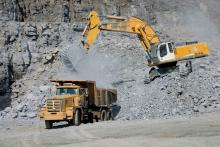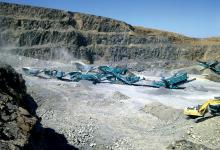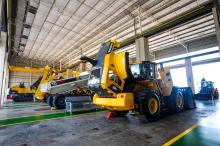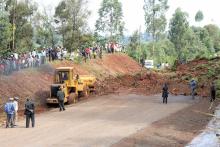
Sub-Saharan Africa’s infrastructure deficit presents a perfect storm of opportunities for the broader spectrum of the building and construction materials value chain, ranging from aggregate suppliers through to the equipment supply chain.
It is a well-quoted fact that sub-Saharan Africa is historically among the least developed regions of the world, and as it plays catch-up with the rest of the world, the pace of its construction activity is rapid and causing a major shift for the building materials industry at large.
Infrastructure development is playing a significant role in sub-Saharan Africa’s economic turnaround, and countries understand that closing the infrastructural gap will be crucial if any development targets are to be reached. In most countries in the region, infrastructure is a major hurdle to doing business, and is predicted to depress productivity by as much as 40%.
Africa GDP grew by 5.3% in 2014 and is forecast to grow 5.7% this year, while sub-Sahara Africa’s grew 6.1% in 2014 and is predicted to grow 5.8% in 2015, according to Deloitte’s African Construction Trends Report. Despite current dwindling mineral commodity prices, Africa’s growth continues to be reinforced by the natural resources sector, which underpins the rising fiscal spend in infrastructure projects.
Deloitte reports that investment by value into mega infrastructure projects already under construction in sub-Sahara Africa grew by 42.6% in 2014, a weighty increase of more than US$103 billion from $222 billion in 2013 to $326 billion in 2014. The African Development Bank notes a significant increase in airport construction projects in sub-Saharan Africa. In 2015, a total of 25 new greenfield and brownfield airport projects have been recorded, according to Paul Runge, managing director of Africa Project Access. This is complemented by the soaring investment in real estate, which forms an integral part of the emerging markets’ growth phenomenon.
Southern Africa remains at the forefront of the African infrastructure development story with a whopping total spend in projects reaching US$145 billion last year, representing 46% of the total projects under construction on the continent, according to the Deloitte report. Despite a small economic growth of 1.5% in 2014, down from 2.2% the previous year, South Africa remains the pillar of Southern Africa’s growth story, and is home to half of projects under way in the region. Mozambique and Angola follow with respective 15% and 13% of total projects under construction in Southern Africa.
South Africa inarguably has the most mature aggregates market in the region, kept under the watchful eye of the Aggregate and Sand Producers of Southern Africa (Aspasa) and the regulation of the country’s Department of Mineral Resources (DMR). The DMR lists a total of 701 quarrying operations, 580 of which are aggregates and natural sand quarries. The Chamber of Mines set the 2012 value of aggregate and sand production at 53 million tonnes, and $332.98 million. Recent figures from the DMR show a significant increase with sand and aggregate production hitting the 100 million tonne mark last year.
Despite slow economic growth in South Africa, Nico Pienaar, director of Aspasa, says construction industry trends in the country are encouraging, with retail and residential building activity at the forefront of the construction bustle. Pienaar says that even in the absence of large civil builds, the present hive of activity in commercial and residential building is enough to see aggregate suppliers outstrip 2014 sales figures. The sand and aggregate sector accounts for 11% of building materials sold in the country. It is the second-largest behind cement, which accounts for 16.21% of the industry. However, by volume, the sand and aggregate sector is the largest, moving well over 100 million tonnes of material to the construction industry every year compared to cement’s 18 million tonnes/year.
Meanwhile, Mozambique is also undoubtedly a hot spot for aggregate producers as it continues en route to becoming a sustained high growth zone. According to the Deloitte report, it has more than $24 billion worth of construction projects under way. Over the past two years, it has attracted well over $5billion in foreign investment.
West Africa is the second biggest region as far as investment into infrastructure development is concerned. Total value of projects under construction increased from US$50 billion in 2013 to US$75 billion in 2014. Although the region only accounts for just half of Southern Africa’s spend, it is starting to close its infrastructure gap, anchored by Nigeria with its new title as the biggest economy in Africa.
With a large population of 170 million people, coupled with a rebased economy that now stands at the helm of African economies, Nigeria is a hot spot for the building and construction materials value chain at large. Its construction growth will be the fastest of all global markets by 2018, according to Global Construction Perspectives’ Global Construction 2020 report. It says Nigeria is the “global hot spot from here to 2020” and its construction growth will even be faster than that of India.
On average, the value of a country’s core infrastructure, including roads, railways, ports, airports and electrical system, is about 70% of its GDP, and in Nigeria, core infrastructure is only believed to be about 35 to 40% of GDP. The country has one-seventh the roads per kilometre as India. On a per capita basis, Nigeria has one-third the residential buildings of Indonesia and one-sixth of the commercial space. These are shortfalls which translate into extensive construction opportunities as the country plays catch-up with economies in its class size. Between core infrastructure and real estate, total investments in Nigeria are predicted to reach $1.5 trillion between 2014 and 2030. As a result, Nigeria’s aggregates industry is expected to further grow as local suppliers ramp up production to close the widening gap between supply and rising demand, according to the country’s Bureau of Statistics.
East Africa has about $67 billion worth of construction projects under way. It is historically among Africa’s least developed regions, but with ongoing infrastructure development, coupled with several member countries boasting higher GDPs, the region has transformed into a strategic hub for aggregate producers. With countries such as Ethiopia (9,5% in 2015) and Rwanda (7% in 2015) relishing higher GDPs, Kenya’s infrastructure development projects firing from all cylinders and Tanzania’s oil and gas finds turning the heads of investors, East African aggregate suppliers have also seen increased demand. Aggregate-intensive transport projects dominate the region’s spend, accounting for 59% of all projects under construction.
On the back of exponential construction growth, construction equipment makers also report increased business in sub-Saharan Africa. Ian Sayers, sales director of
Sayers believes East Africa is one of the most strategic markets for JCB, especially Kenya, Uganda and Ethiopia. JCB recently established its regional office in Nairobi, Kenya. Ethiopia was the sixth biggest construction equipment market in Africa with a total of 706 units in 2012, while Kenya made the same position in 2014 with a slightly higher figure of 790 units.
Terry Gillham, director of sales and marketing at
Gillham observes that ADTs are now the preferred choice in the quarrying industry because they are flexible and offer a competitive cost per tonne solution. “We have found that the most preferred trucks for the quarrying applications are the B25 and the B30 models, and in some instances we have B40s operating at quarries.” As a result, Gillham says about 70% of Bell Equipment’s ADT complement is used in quarries and smaller opencast mining operations.
Due to increased aggregate intensive projects, mobile crushing and screening equipment is taking a more important place in operators’ portfolios, and to meet the growing demand for flexibility in running this gear, Terex Finlay also recently introduced its first dual powered crushing and screening train in Africa. Neil Mcllwaine, business development director at
Tomas Kuta, president of Volvo Construction Equipment (CE) EMEA, says the African equipment market is generally challenging at the moment, especially on the back of slow mining activity in South Africa. The country accounts for 50% of










